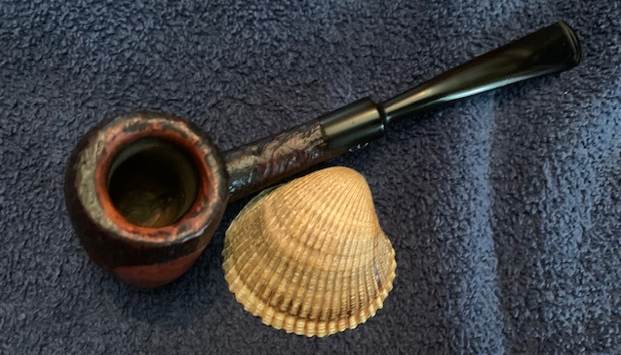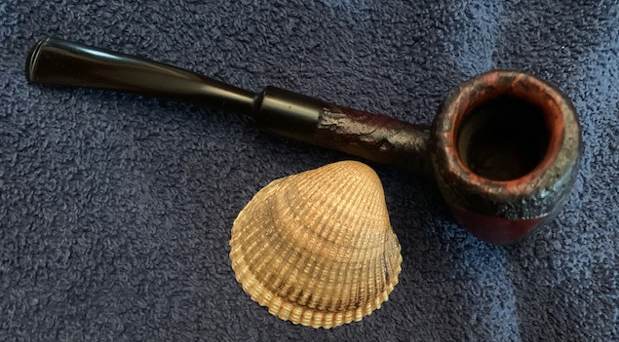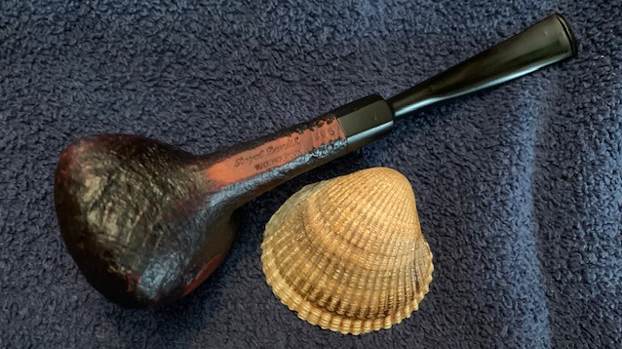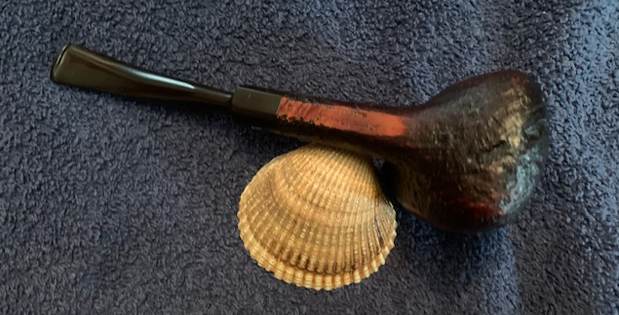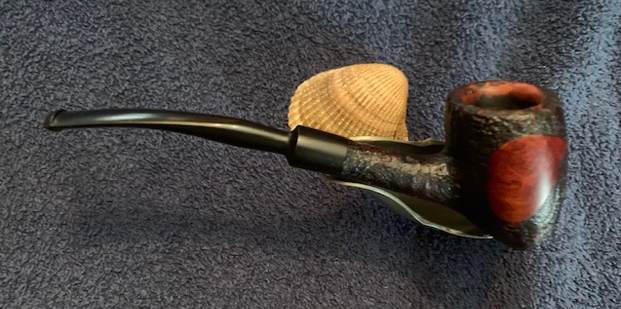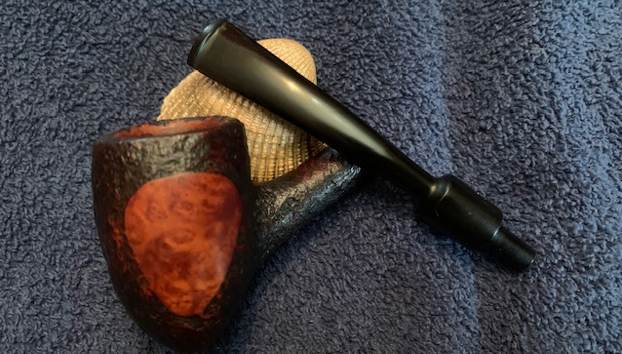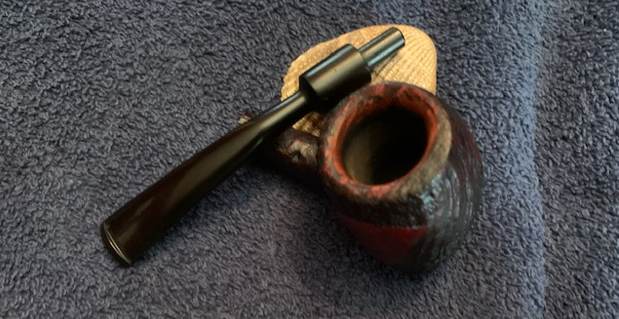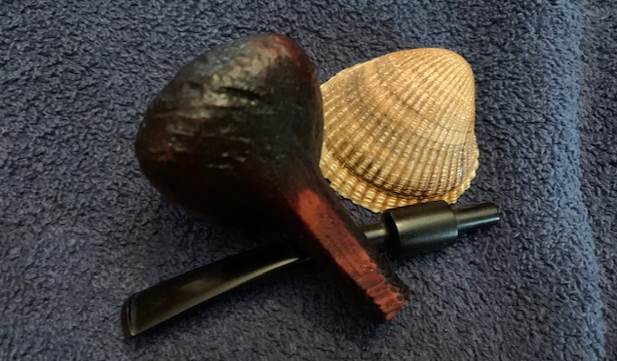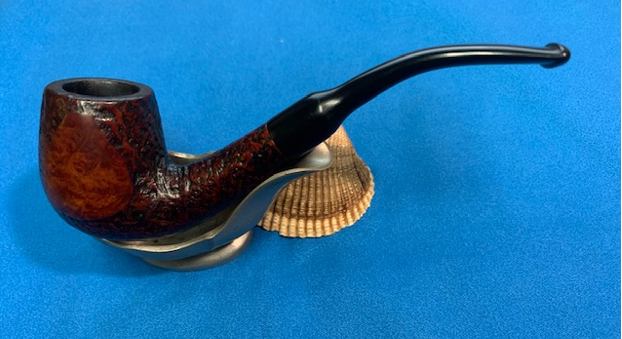Blog by Steve Laug
The next pipe on the worktable is an obvious Stanwell shaped pipe. It has a mixed finish – sandblast on the bowl and shank with smooth panels on the left and right as well as the underside of the shank. The sandblast finish is quite beautiful even through the grime. It was purchased on 05/10/22 from an antique mall in Astoria, Oregon, USA. The shape of the pipe is very odd in my opinion – almost oval but odd and able to sit on the desk top. There is a Crown logo stamped in the left side of the saddle stem. It was stamped on the underside of the shank on a smooth panel. It reads Royal Danish [over] Made in Denmark. The shape number 996 is stamped next to the shank/stem junction. The finish was dirty with dust and grime ground into the nooks and crannies of the sandblast finish. The smooth panels on each side were dirty with oils and grime. There was a thick cake in the bowl and lava overflow on the rim top. The inner edge of the rim was covered so thickly in lava it was hard to know what was underneath. The front top and outer edge were rough from knocking the pipe out on hard surfaces. The vulcanite fancy saddle stem was calcified, oxidized and had tooth marks and chatter ahead of the button on both sides. Jeff took some photos of the pipe before he started to work on cleaning it up for us. 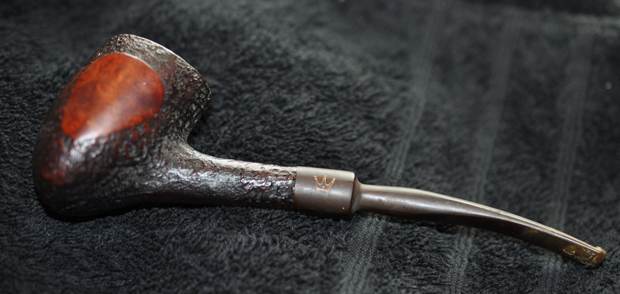
 Jeff took photos of the rim top and the stem to show the condition of the pipe when we received it. You can see the thick cake in the bowl and the heavy coat of lava filling in the blast on the rim top and inner edge of the bowl. The damage on the top front and outer edge is also visible. The stem is calcified and oxidized with light tooth chatter and marks on both sides near the button.
Jeff took photos of the rim top and the stem to show the condition of the pipe when we received it. You can see the thick cake in the bowl and the heavy coat of lava filling in the blast on the rim top and inner edge of the bowl. The damage on the top front and outer edge is also visible. The stem is calcified and oxidized with light tooth chatter and marks on both sides near the button. 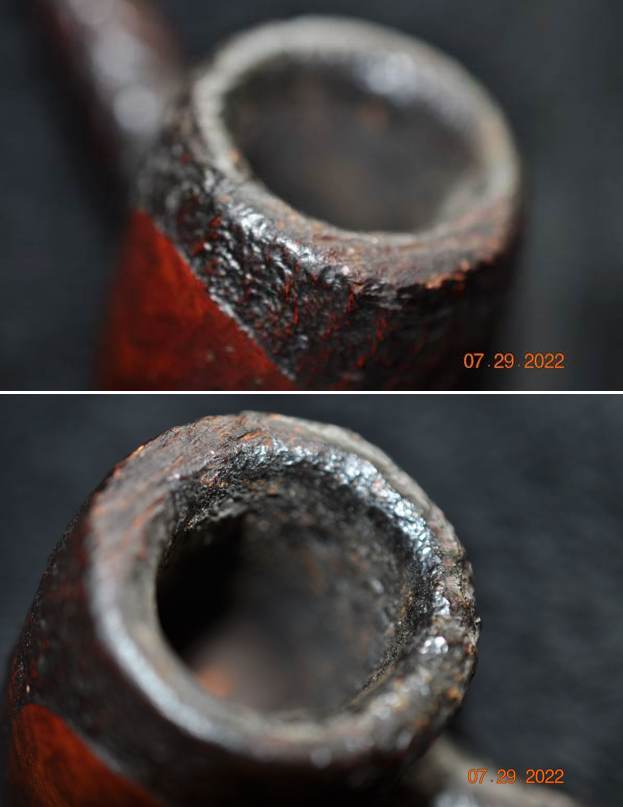
 He took photos of the sides of the bowl and the heel to give an idea of the shape and the condition of the briar around the bowl. It really is a strangely shaped pipe in my opinion but it has a great sandblast with smooth patches on the bowl sides.
He took photos of the sides of the bowl and the heel to give an idea of the shape and the condition of the briar around the bowl. It really is a strangely shaped pipe in my opinion but it has a great sandblast with smooth patches on the bowl sides. 
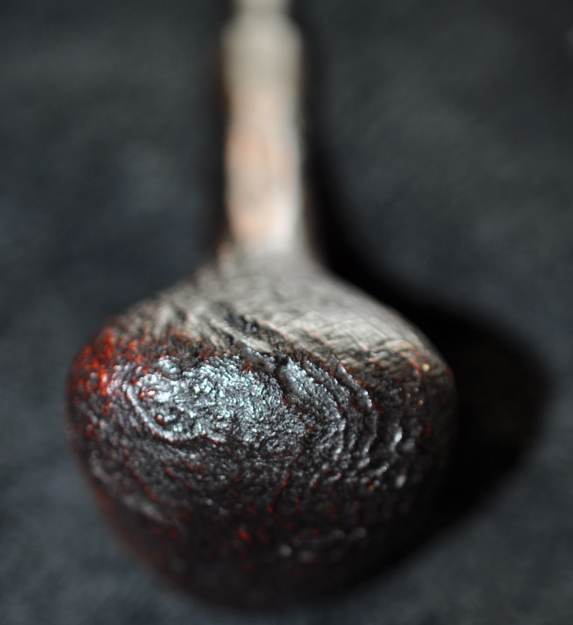 The next photo Jeff took shows the stamping on the underside of the shank. It is clear and readable as noted above. The Crown logo is also visible on the left side of the saddle stem.
The next photo Jeff took shows the stamping on the underside of the shank. It is clear and readable as noted above. The Crown logo is also visible on the left side of the saddle stem.  Regardless of when this specific briar was made, the shape is very much a 1960s Danish one. I turned to Pipephil’s site and quickly scanned the article on Stanwell getting a great overview of the history. I went through the photos and did not find the shape of the pipe that I was working on (http://pipephil.eu/logos/en/logo-r6.html). There was one that showed the mixed finish of the Royal Danish line – sandblast with smooth patches on each side of the bowl. I have included a screen capture of that section below.
Regardless of when this specific briar was made, the shape is very much a 1960s Danish one. I turned to Pipephil’s site and quickly scanned the article on Stanwell getting a great overview of the history. I went through the photos and did not find the shape of the pipe that I was working on (http://pipephil.eu/logos/en/logo-r6.html). There was one that showed the mixed finish of the Royal Danish line – sandblast with smooth patches on each side of the bowl. I have included a screen capture of that section below. I then turned to Pipedia and found that the Royal Danish was also listed as a second or a sub-brand made by Stanwell (https://pipedia.org/wiki/Stanwell#Sub-brands_.2F_Seconds). I have included the list of seconds from the site below. I have highlighted the Royal Danish in blue in the text.
I then turned to Pipedia and found that the Royal Danish was also listed as a second or a sub-brand made by Stanwell (https://pipedia.org/wiki/Stanwell#Sub-brands_.2F_Seconds). I have included the list of seconds from the site below. I have highlighted the Royal Danish in blue in the text.
Sub-brands / Seconds – Bijou (discontinued), Danish Quaint, Danish Sovereign, Danske Club, Henley (discontinued), Kong Christian (discontinued), Majestic, Reddish (discontinued), Royal Danish, Royal Guard, Royal Sovereign, Sailor (discontinued), Scandia, Sorn (discontinued), Svendson.
There was also an interesting advertising page on the Danish Briars by Stanwell. The first one on the list was the Royal Danish. The description of the line is clear and concise, be sure to read it below. I followed one of the links at the end of the site to an article on rebornpipes written by Bas Stevens on the shape numbers and the designers who originally carved those shapes for Stanwell (https://pipedia.org/wiki/Stanwell_Shape_Numbers_and_Designers). The Royal Danish line adds a 9 before the 96 making the number 996. I quote from it as it specifically refers to the shape 96 as being a design by Sixten Ivarsson.
I followed one of the links at the end of the site to an article on rebornpipes written by Bas Stevens on the shape numbers and the designers who originally carved those shapes for Stanwell (https://pipedia.org/wiki/Stanwell_Shape_Numbers_and_Designers). The Royal Danish line adds a 9 before the 96 making the number 996. I quote from it as it specifically refers to the shape 96 as being a design by Sixten Ivarsson.
- Freehand, oval bowl, long saddle mouthpiece by Sixten Ivarsson. It also appears to be a rare shape that has been compared to a potato sack.
Jeff had cleaned up the pipe following his normal cleaning process. In short, he reamed the bowl with a PipNet pipe reamer and cleaned up the reaming with a Savinelli Fitsall Pipe Knife. He scrubbed the smooth bowl with undiluted Murphy’s Oil Soap with a tooth brush. He worked over the lava and debris on the rim top and was able to remove it. He rinsed it under running warm water to remove the soap and grime. He cleaned out the inside of the shank and the airway in the stem with alcohol, cotton swabs and pipe cleaners. He scrubbed the stem with Soft Scrub and cotton pads to remove the debris and oils on the stem. He soaked it in a bath of Briarville’s Pipe Stem Deoxidizer to remove the oxidation. He rinsed it with warm water and dried it off. I took photos of the pipe once I received it. It really looked good. 
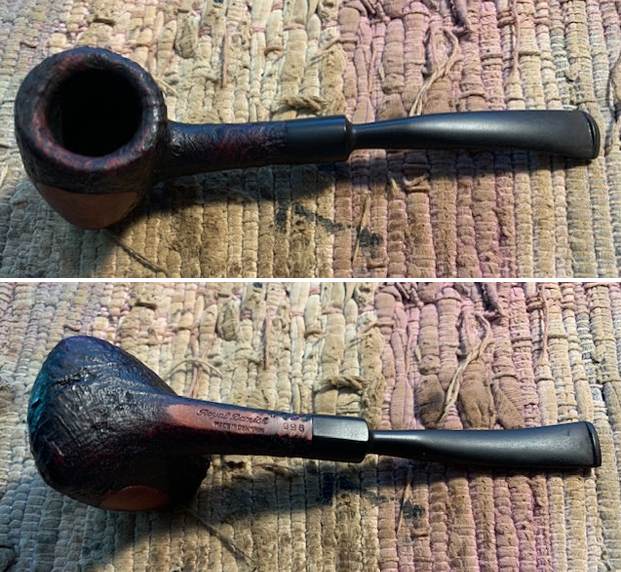 I took close up photos of the stem and the rim top to show both how clean they were and what needed to be addressed with both. The rim top and bowl edges look better but the inner and outer edge was damaged on the front of the bowl. The stem looked better and the tooth marks and chatter was very light.
I took close up photos of the stem and the rim top to show both how clean they were and what needed to be addressed with both. The rim top and bowl edges look better but the inner and outer edge was damaged on the front of the bowl. The stem looked better and the tooth marks and chatter was very light. 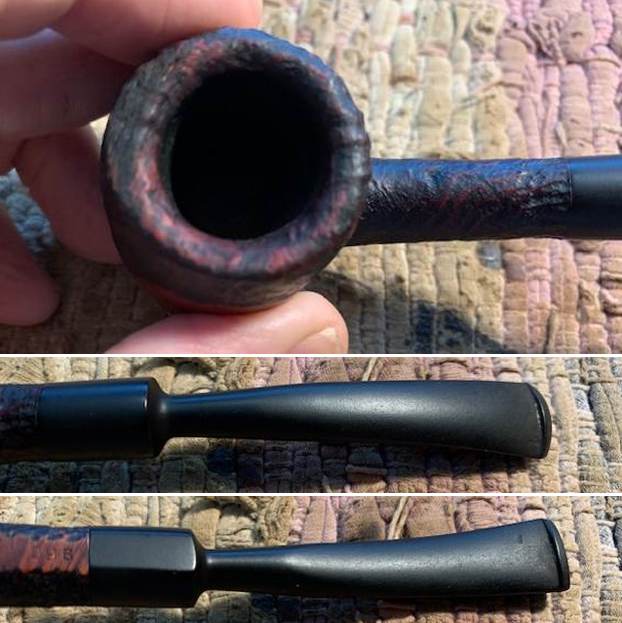 I took a photo of the stamping on the underside of the shank. You can see from the photo that it is clear and readable. I also captured the stamping of the crown on the left side of the saddle stem.
I took a photo of the stamping on the underside of the shank. You can see from the photo that it is clear and readable. I also captured the stamping of the crown on the left side of the saddle stem.  I removed the stem from the bowl and took a photo of the parts to give a sense of the beauty of the pipe.
I removed the stem from the bowl and took a photo of the parts to give a sense of the beauty of the pipe. I started my work on the pipe by addressing the damage to the inner edge of the bowl with a folded piece of 220 grit sandpaper. I gave the inner edge a light bevel to minimize the damage.
I started my work on the pipe by addressing the damage to the inner edge of the bowl with a folded piece of 220 grit sandpaper. I gave the inner edge a light bevel to minimize the damage. I polished the smooth patches on the bowl sides and the inner edge of the bowl with micromesh sanding pads – dry sanding with 1500-12000 grit sanding pads. I wiped it down with a damp cloth after each pad to remove the debris. The smooth portions took on a rich glow.
I polished the smooth patches on the bowl sides and the inner edge of the bowl with micromesh sanding pads – dry sanding with 1500-12000 grit sanding pads. I wiped it down with a damp cloth after each pad to remove the debris. The smooth portions took on a rich glow.
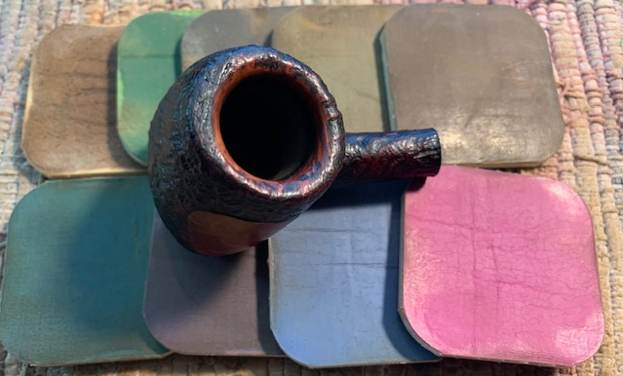 I worked some Before & After Restoration Balm into the briar with my finger tips and into the blast with a shoe brush. The product works to clean, revive and protect the briar. I let it sit on the pipe for 10 minutes then buffed it off with a soft cloth.
I worked some Before & After Restoration Balm into the briar with my finger tips and into the blast with a shoe brush. The product works to clean, revive and protect the briar. I let it sit on the pipe for 10 minutes then buffed it off with a soft cloth. 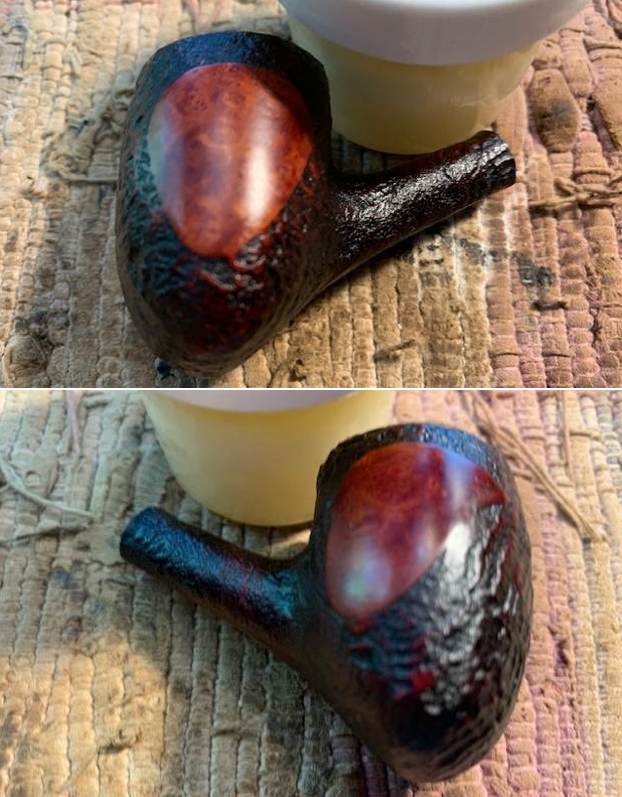
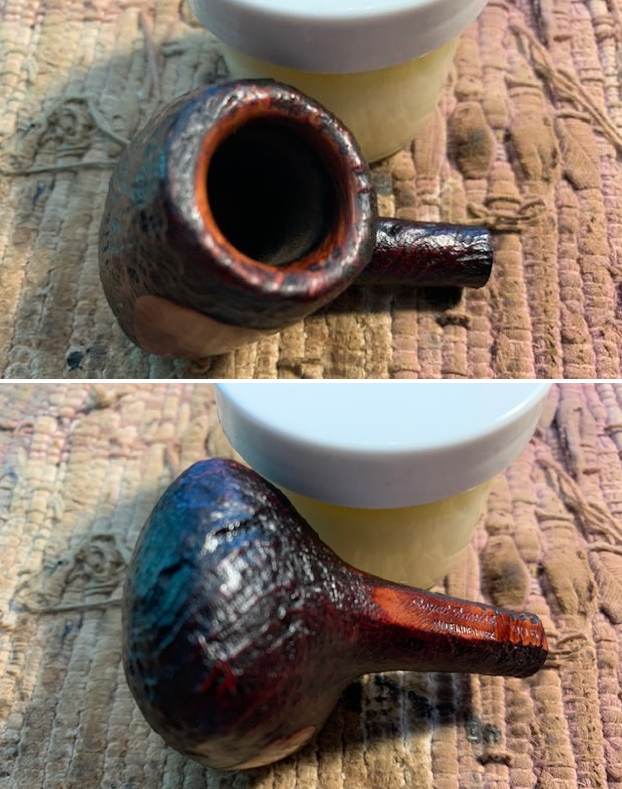
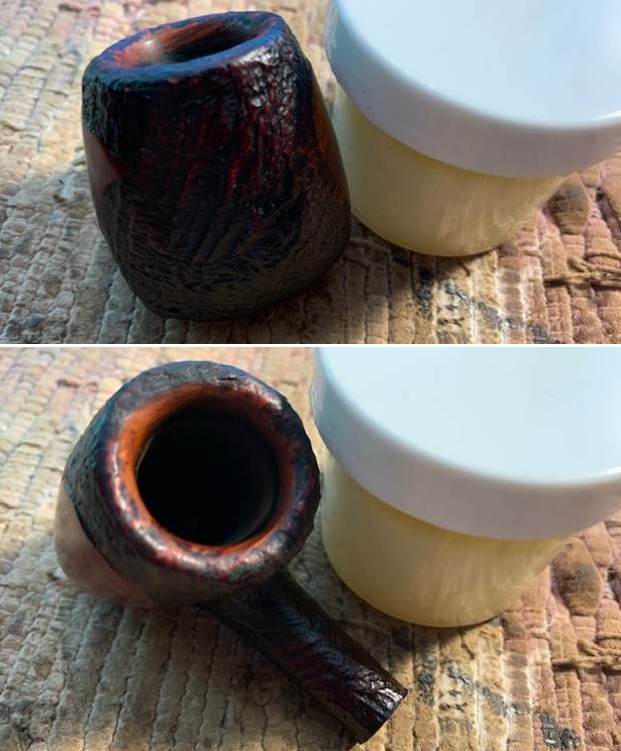 I set the bowl aside and turned my attention to the stem. I “painted” the tooth marks and chatter on the surface of the vulcanite with the flame of a Bic lighter to lift them. I was able to raise the majority of them with the heat. I sanded out those that remained with 220 grit sandpaper. I started polishing the stem with 400 grit wet dry sandpaper.
I set the bowl aside and turned my attention to the stem. I “painted” the tooth marks and chatter on the surface of the vulcanite with the flame of a Bic lighter to lift them. I was able to raise the majority of them with the heat. I sanded out those that remained with 220 grit sandpaper. I started polishing the stem with 400 grit wet dry sandpaper. 
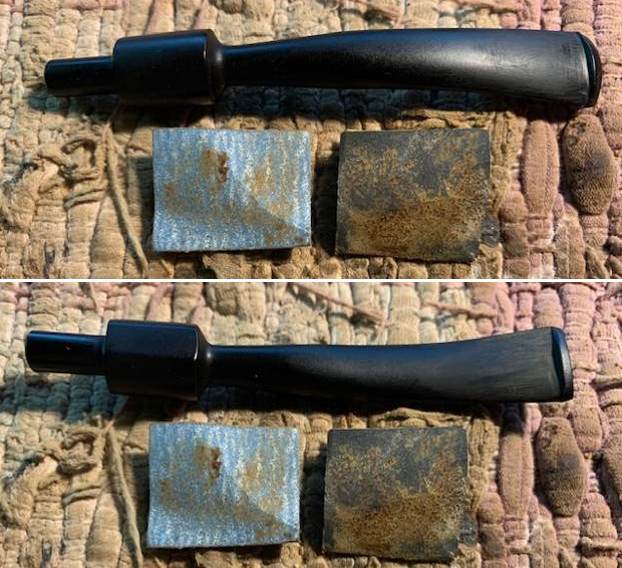 I applied some acrylic white nail polish to the stamping on the stem side.
I applied some acrylic white nail polish to the stamping on the stem side. I polished out the sanding marks on the stem with micromesh sanding pads – dry sanding it 1500-12000 pads. I wiped it down with some Obsidian Oil each pad to remove the dust and polishing debris. I polished it with Before After Pipe Polish – both Fine and Extra Fine. I gave it a final coat of Obsidian Oil and set it aside to dry.
I polished out the sanding marks on the stem with micromesh sanding pads – dry sanding it 1500-12000 pads. I wiped it down with some Obsidian Oil each pad to remove the dust and polishing debris. I polished it with Before After Pipe Polish – both Fine and Extra Fine. I gave it a final coat of Obsidian Oil and set it aside to dry. 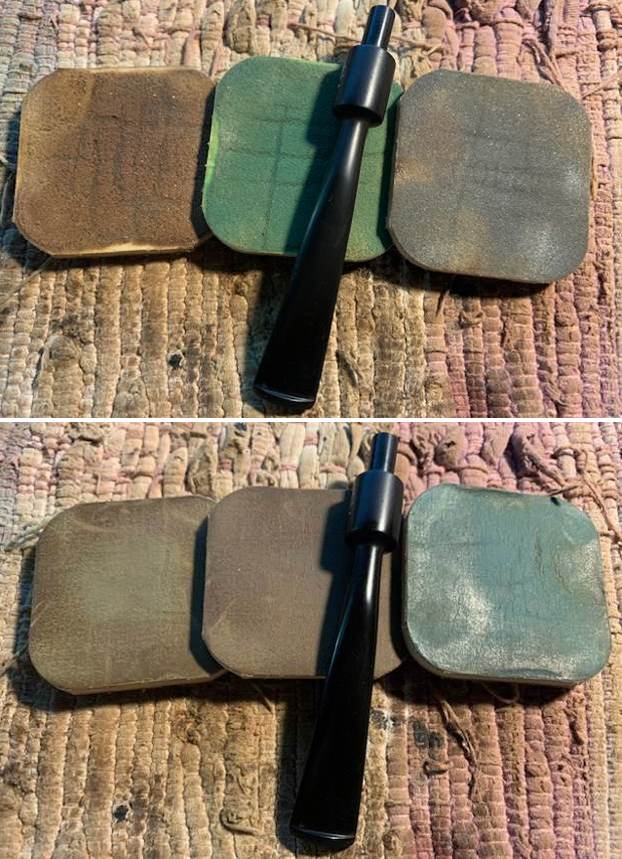
 This is another pipe that I am really happy about the look of the finished restoration. This reborn Sixten Ivarrson Design Royal Danish 996 Sandblast Freehand turned out really well. I think that it really is a great looking pipe with a great shape and grain. The freehand/plateau top bowl and the vulcanite saddle stem goes well together. The polished black of the stem works well with the briar. The briar really came alive with the buffing. The rich brown stains of the finish make the grain really pop with the polishing and waxing. I put the stem back on the bowl and buffed the pipe with Blue Diamond on the buffing wheel. I gave the bowl and the stem multiple coats of carnauba wax on the buffing wheel. I buffed the pipe with a clean buffing pad to raise the shine. I hand buffed the pipe with a microfiber cloth to deepen the shine. The finished Royal Danish 996 Sandblast Freehand really feels great in the hand and it looks very good. Give the finished pipe a look in the photos below. The dimensions of the pipe are Length: 5 ¾ inches, Height: 2 inches, Outside diameter of the bowl: 1 ¼ inches, Chamber diameter: ¾ of an inch. The weight of the pipe is 39 grams/1.38 oz. The pipe will be going on the rebornpipes store soon. It will be in the Danish Pipe Makers Section if you would like to add it to your collection. Thanks for reading this blog and my reflections on the pipe while I worked on it. It was a fun one to work on!
This is another pipe that I am really happy about the look of the finished restoration. This reborn Sixten Ivarrson Design Royal Danish 996 Sandblast Freehand turned out really well. I think that it really is a great looking pipe with a great shape and grain. The freehand/plateau top bowl and the vulcanite saddle stem goes well together. The polished black of the stem works well with the briar. The briar really came alive with the buffing. The rich brown stains of the finish make the grain really pop with the polishing and waxing. I put the stem back on the bowl and buffed the pipe with Blue Diamond on the buffing wheel. I gave the bowl and the stem multiple coats of carnauba wax on the buffing wheel. I buffed the pipe with a clean buffing pad to raise the shine. I hand buffed the pipe with a microfiber cloth to deepen the shine. The finished Royal Danish 996 Sandblast Freehand really feels great in the hand and it looks very good. Give the finished pipe a look in the photos below. The dimensions of the pipe are Length: 5 ¾ inches, Height: 2 inches, Outside diameter of the bowl: 1 ¼ inches, Chamber diameter: ¾ of an inch. The weight of the pipe is 39 grams/1.38 oz. The pipe will be going on the rebornpipes store soon. It will be in the Danish Pipe Makers Section if you would like to add it to your collection. Thanks for reading this blog and my reflections on the pipe while I worked on it. It was a fun one to work on!

